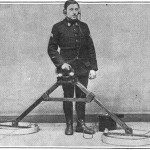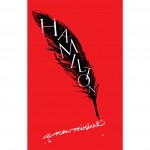I’ve been making some progress on the books I earmarked to read in 2016, but I had to make time for a book titled Catapult: Harry and I Build a Siege Weapon, which was pretty much everything I hoped it would be. Here’s a passage from early in the book:
I got off the phone, surprised by the force of this whim to build a catapult. Where was that coming from? I wondered. I had never wanted anything like it. I had never even owned a weapon. I held onto the rock and wandered around the apartment, agitated, fancying that I felt some insistence from the stone itself, from the Red Creek quartzite. Its heft was just out of my range, its bulk too much for my arm to manage, had I decided to throw it. So the thing could have been calling for some sort of machine to toss it harder than I could. It was an odd thought, that a stone could suggest anything, as if some rocks ask with their whole weight to be put to flight.
Something else you may want to drop everything to make time for: Orson Welles’s Chimes at Midnight, an adaptation of the Henriad (in which he plays Falstaff) is in theatres and is, according to First Thing’s Alexi Sargeant, spectacular: (much like First Thing’s Alexi Sargeant)
Falstaff at war is a parody of the other knights: too fat to be hoisted onto a horse, he spends the battle as a tubby suit of armor, waddling from tree to tree, justifying his mid-battle feint of death with “the better part of valor is discretion.” His pleas for peace are craven but sweet: right before battle is joined, he says, “I would it were bed-time Hal, and all well.” Welles presents the fat knight as an unlikely prophet, rebuking the absurd folly of war in his very shape—an inversion of the spindly Don Quixote, satirizing not knight-errantry but the brutality of the battlefield. England would be a more peaceful place if his example were heeded.
Like other great prophets of peace, Falstaff is headed for a fatal betrayal by a friend. His unlikely garden of Gethsemene realization comes when he intones “I am old, I am old” to whore Doll Tearsheet (Jeanne Moreau). He is part of the generation passing away: Welles cuts between King Henry IV dying in his drafty castle and Falstaff sitting morosely with the doddering Shallow and the melancholy Silence (not subtle naming on Shakespeare’s part). It is here that the title line of the film fits chronologically: but Welles chooses instead to flash-forward to this moment for the movie’s opening, so we hear Falstaff say, “We have heard the chimes at midnight, Master Shallow,” before we know just why thinking of his youthful escapades makes him so heavy-hearted.
Chimes has a series of limited showing around the country (listed here). I have foolishly arranged to be in DC when the movie is showing in NY and vice versa, but I strongly suggest you all go out to see it in my stead, while I languish waiting for a DVD.
There’s a different sort of spectacle on display in New York, where the Museum of Natural History has set up a replica of one of the world’s largest dinosaurs. The NYT has a nice story with a delightful slideshow of people wheeling gargantuan dinosaur parts through the museum for assembly.
(And, over at FiveThirtyEight, Dave Goldenberg has a great feature on the possibly largest, possibly faked dinosaur).
Even more difficult to piece together than a dinosaur is a tangled yarn skein, but there are people who specialize (and delight!) in doing just that. The WSJ has a story on detanglers who never exclaim “O time! thou must untangle this, not I; It is too hard a knot for me to untie!”
The most acclaimed project in the group’s tangled history is known to knitters as “the Stash Disaster of Epic Proportion.” In 2011, a Sacramento, Calif., knitter was cataloging her entire stash of yarn in her backyard—only to leave it out during a rainstorm. She tossed the 30 to 50 balls of soaking-wet yarn into the dryer, producing further chaos.
More than a dozen volunteers stepped up, “drooling over the delicious detangling it promises,” as one member put it. The project, about the size of a lamb, was carried in a bedsheet to places such as a library and a park, where detanglers picked at it together. It also made its way to the homes of several detanglers.
I’ve gotta say, I felt a real kinship with the detanglers. I’m always quick to volunteer to sort out a shoelace or unsnarl headphones, because there is a particular pleasure of bringing a big mess to order. It might not be the most exciting or important blow to strike against entropy, but it still has something Wizard’s Oath-y about it.
Michael Dukakis is also passionately devoted to making use of what other people would discard. I learned from the Boston Globe that he tells friends to bring him their turkey carcasses after Thankgiving, rather than throw them out.
He preserves the carcasses, stuffing seven or eight of them in his freezer after each Thanksgiving, which on its own is quite a feat, requiring sharp scissors to get the bones down to a more reasonable size.
“You cut them up. And wrap them up,” he says. “You can fit them in there as easily as possible. When the time comes, you pull them out.”
Throughout the course of the year, once every month or two, he removes one of the carcasses. He gets out a pot. He pours enough water to cover the bones, adds an onion, and lets it simmer for at least three hours. He cleans the meat off the bones, he adds in rice and any assortment of vegetables (“Peas are good. Carrots are good”). He heats it up, and relishes the smell that permeates the house on Perry Street.
(He allowed his home address to be printed at the bottom of the article, so that readers could also bring him turkey carcasses, if they want to).
When it comes to industrial recycling, Ars Technica has a great feature on how recycling plants manage to separate different materials out of single stream recycling. The engineering is delightful!
The optical scanners shine light down from over the conveyor and read the wavelengths that are reflected back to it. That way, it identifies where items with a specific composition are on the conveyor.
For this to actually work, however, items can’t be piled on top of each other. So there’s a separate piece of machinery placed upstream of the scanner. There, a series of physical barriers and moving plates push items that are stacked on top of each other. By the time the conveyor belt emerges on the far side, everything is in a single layer of flattened plastic items.
The optical scanners are placed a set distance from the end of the conveyor; given that it’s moving at a known rate, it’s possible to know when a specific item will reach the end of the conveyor, its rough shape, and what it’s made of.
At the edge where the conveyor dumps its materials, there’s a bar with a series of small holes in it. When a piece of the desired plastic crosses it, these holes let out a blast of compressed air in the region where it passes over the bar. That’s enough to flip the plastic over a barrier and into a separate stream. Everything else falls straight down and continues for further sorting.
I don’t have a good segue from that to this video of small children doing cosplay, but… wait, why are you still reading this text, I already told you there’s a cute vid of kids in costume just below!
For more Quick Takes, visit Conversion Diary!













